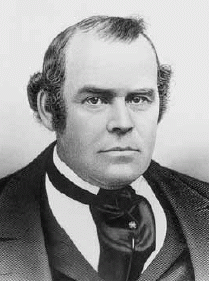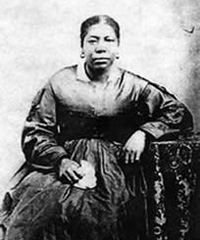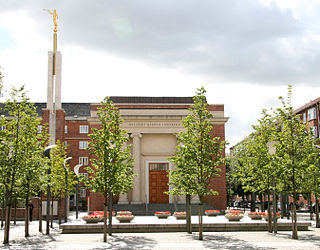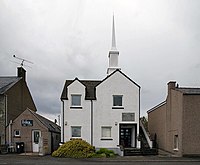
Parley Parker Pratt Sr. was an early leader of the Latter Day Saint movement whose writings became a significant early nineteenth-century exposition of the Latter Day Saint faith. Named in 1835 as one of the first members of the Quorum of the Twelve Apostles, Pratt was part of the Quorum's successful mission to Great Britain from 1839 to 1841. Pratt has been called "the Apostle Paul of Mormonism" for his promotion of distinctive Mormon doctrines.

Hugh Findlay was one of the first two Mormon missionaries to enter India and initiated Mormon missionary work in the Shetland Islands.

Phineas Howe Young was a prominent early convert in the Latter Day Saint movement and was later a Mormon pioneer and a missionary for the Church of Jesus Christ of Latter-day Saints. Phineas Young was an older brother of Brigham Young, who was the president of the LDS Church and the first governor of the Territory of Utah.

Since its organization in New York in 1830, the Church of Jesus Christ of Latter-day Saints has had a presence in Canada. Several church-related items that were the first of their kind outside the United States include: missionaries preaching, establishment of a stake, and construction of a temple.

The Church of Jesus Christ of Latter-day Saints in Michigan refers to the Church of Jesus Christ of Latter-day Saints and its members in Michigan. Members of the Church of Jesus Christ of Latter-day Saints arrived in Michigan in the 1830s, and while the Church did not continue to have an organized presence in the state from the late 1850s into the 1870s, missionary work was reopened then by Cyrus Wheelock and has progressed steadily since.

The Church of Jesus Christ of Latter-day Saints has had a presence in Mexico since 1874. Mexico has the largest body of LDS Church members outside of the United States. Membership grew nearly 15% between 2011 and 2021. In the 2010 Mexican census, 314,932 individuals self-identified most closely to the LDS Church.

The Church of Jesus Christ of Latter-day Saints in Australia began with the arrival of seventeen-year-old missionary William James Barratt in 1840. The LDS Church's first baptism in Australia was in 1842 when Barratt baptised Robert Beauchamp, who would later become an Australian mission president. However, official missionary work did not begin until John Murdock, who became the first official mission president in Australia, and Charles Wandell established a mission in Sydney, Australia, on 31 October 1851. The colonies of New Zealand and Tasmania were added to the Australian Mission in 1854, creating the Australasian Mission. In 1898, however, the Australasian Mission was divided into the New Zealand Mission and the Australian Mission.

The Church of Jesus Christ of Latter-day Saints in Norway is a restorationist free church. There are more than 4,500 members in Norway. A temple to be built in Oslo was announced on April 4, 2021 by church president Russell M. Nelson.

Since Mormonism's foundation, Black people have been members; however, the church placed restrictions on proselytization efforts among Black people. Before 1978, Black membership was small. It has since grown, and in 1997, there were approximately 500,000 Black members of the church, mostly in Africa, Brazil and the Caribbean. Black membership has continued to grow substantially, especially in West Africa, where two temples have been built. By 2018, an estimated 6% of members were Black worldwide. In the United States, approximately 1% of members are Black.

The Church of Jesus Christ of Latter-day Saints in England refers to the Church of Jesus Christ of Latter-day Saints and its members in England. England has five missions, and both temples in the United Kingdom. With 145,385 members in 2011, England had more LDS Church members than any other country in Europe.

The Church of Jesus Christ of Latter-day Saints was established in Argentina in 1925 when Melvin J. Ballard arrived in Buenos Aires and opened the church's South American Mission.

The Church of Jesus Christ of Latter-day Saints in Germany refers to the Church of Jesus Christ of Latter-day Saints and its members in Germany.

Three missionaries of the Church of Jesus Christ of Latter-day Saints started proselyting to white English-speaking people in Cape Town in 1853. Most converts from this time emigrated to the United States. The mission was closed in 1865, but reopened in 1903.The South African government limited the amount of missionaries allowed to enter the country in 1921 and in 1955. Starting around 1930, a man had to trace his genealogy out of Africa to be eligible for the priesthood, since black people were not permitted to be ordained. In 1954 when church president David O. McKay visited South Africa, he removed the requirement for genealogical research for a man to be ordained, stipulating only that "there is no evidence of his having Negro blood in his veins".

The Church of Jesus Christ of Latter-day Saints has had a presence in the island of Ireland since at least 1840, when the Elder John Taylor first preached in Newry. He and other missionaries converted a number of Irish people, forming a branch in Hillsborough, County Down. Many of the converted Irish saints emigrated in order to escape poverty, as well as to live in majority Latter Day Saint communities. Missionary efforts continued in the 1850s, and a small branch was established in Dublin, but many members emigrated to Utah or lost interest in the church. In 1867, the Irish mission was placed in the care of the British mission. A new branch was formed in Belfast in 1884 and a Dublin branch was reestablished in 1900. All of this occurred despite anti-Mormon disturbances by local Irish people.

The Church of Jesus Christ of Latter-day Saints in Wales refers to the Church of Jesus Christ of Latter-day Saints and its members in Wales.

The Church of Jesus Christ of Latter-day Saints in the Isle of Man refers to the Church of Jesus Christ of Latter-day Saints and its members in the Isle of Man. As of 31 December 2022, The Church of Jesus Christ of Latter-day Saints reported 281 members in one congregation, the Douglas Ward, in the Isle of Man. In 2019, the Isle of Man had the 2nd most LDS Church members per capita in Europe, behind Portugal. Despite their small numbers, Manx Mormons have a heritage going back over a hundred and fifty years, which is obscured by their tendency to emigrate to the US and by the LDS Church administering the Isle of Man as part of England, when it is not actually part of the United Kingdom.

The Church of Jesus Christ of Latter-day Saints has been present in India since the 19th century. As of 2019, there were local members, missionaries and multiple meetinghouses of the LDS Church in the country. The church stated in 2023, that there are 15,224 members from India.

The Church of Jesus Christ of Latter-day Saints in the Czech Republic refers to the Church of Jesus Christ of Latter-day Saints and its members in the Czech Republic. At year-end 1989, there were less than 100 members in the Czech Republic. In 2022, there were 2,643 members in 12 congregations.

The Church of Jesus Christ of Latter-day Saints in Iceland refers to the Church of Jesus Christ of Latter-day Saints and its members in Iceland. Missionary efforts of the Church of Jesus Christ of Latter-day Saints began in 1851 with the baptisms of two native Icelanders visiting Denmark. They returned to Iceland to share the gospel. Missionary work has continued since then, although there were no permanent missionaries in Iceland from 1914 to 1974. As of December 31, 2022, The Church of Jesus Christ of Latter-day Saints had 382 members in Iceland, divided into three congregations. There is also one Family History Center. On January 22, 2023, a Spanish language branch was created in Reykjavík bringing the number of congregation to four.

The Church of Jesus Christ of Latter-day Saints in Denmark refers to the Church of Jesus Christ of Latter-day Saints and its members in Denmark.


























